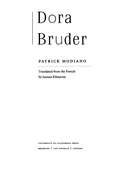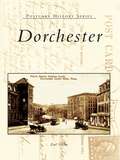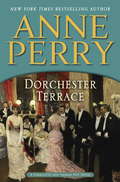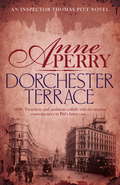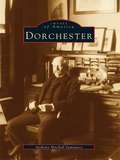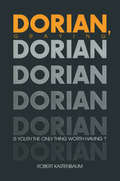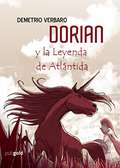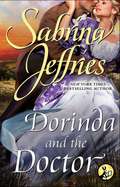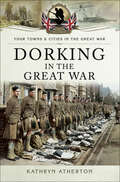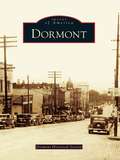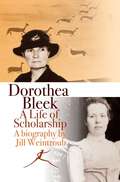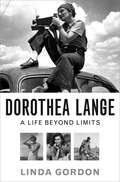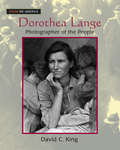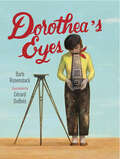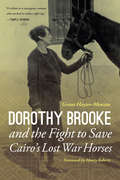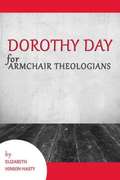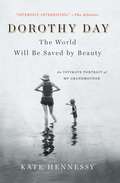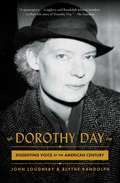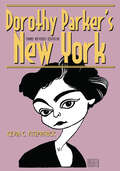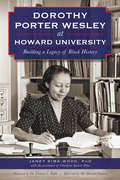- Table View
- List View
Dora Bruder
by Patrick ModianoPatrick Modiano opens Dora Bruder by telling how in 1988 he stumbled across an ad in the personal columns of the New Year's Eve 1941 edition of Paris Soir. Placed by the parents of a 15-year-old Jewish girl, Dora Bruder, who had run away from her Catholic boarding school, the ad sets Modiano off on a quest to find out everything he can about Dora and why, at the height of German reprisals, she ran away on a bitterly cold day from the people hiding her. He finds only one other official mention of her name on a list of Jews deported from Paris to Auschwitz in September 1942. <P><P> With no knowledge of Dora Bruder aside from these two records, Modiano continues to dig for fragments from Dora's past. What little he discovers in official records and through remaining family members, becomes a meditation on the immense losses of the period--lost people, lost stories, and lost history. Modiano delivers a moving account of the ten-year investigation that took him back to the sights and sounds of Paris under the Nazi Occupation and the paranoia of the Pétain regime as he tries to find connections to Dora. In his efforts to exhume her from the past, Modiano realizes that he must come to terms with the specters of his own troubled adolescence. The result, a montage of creative and historical material, is Modiano's personal rumination on loss, both memoir and memorial.
Dora: An Analysis of a Case of Hysteria
by Sigmund FreudThe case history involves a complicated set of liaisons of Dora, her father, her mother, Mr. K., Mrs. K., and the governess.
Dorchester
by Earl TaylorIn the early twentieth century, Dorchester was called "the model town of New England." It was the most favored residential section of Boston, bathed by ocean winds from the east, picturesque rivers and hills to the south, the finest boulevards and parks to the west, and a great city just ten minutes away via the best rapid-transit system in the world. As a result, the population increased from fifteen hundred during the Revolutionary War to two hundred thousand in the early 1900s. Dorchester looks at this neighborly community of skilled mechanics, tradesmen, and professionals through vintage postcards.
Dorchester Terrace: A Charlotte And Thomas Pitt Novel (Charlotte and Thomas Pitt #27)
by Anne PerryAnne Perry's acclaimed Charlotte and Thomas Pitt novels have made London's exclusive world of wealth and power an addictive literary destination for readers everywhere. This new masterpiece, a haunting story of love and treason, invites us not only into the secret places of Britain's power but also into the innermost sanctums of the fin de siècle Austro-Hungarian Empire.Thomas Pitt, once a lowly policeman, is now the powerful head of Britain's Special Branch, and some people fear that he may have been promoted beyond his abilities. He, too, feels painful moments of self-doubt, especially as rumors reach him of a plot to blow up connections on the Dover-London rail line--on which Austrian duke Alois Habsburg is soon to travel to visit his royal English kin.Why would anyone destroy an entire train to kill one obscure Austrian royal, or are the rumors designed to distract Pitt from an even more devastating plot? He must resolve this riddle at once, before the damage is done.Meanwhile, in a London sickroom, an old Italian woman--at the end of a romantic career as a revolutionary spy--is terrified that as she sinks into dementia, she may divulge secrets that can kill. And a beautiful young Croatian woman, married to a British power broker, hoards her own mysteries. Apparently all roads lead to the Continent, and Pitt suspects that between them these two fascinating women could tell him things he desperately needs to know. But as the hours tick by, it seems that the only woman Pitt can count on is his clever wife, Charlotte.No one sustains mesmerizing suspense better than Anne Perry. In Pitt's trial by fire, his wrenching moral dilemma, and his electrifying moment of decision, the beloved bestselling author gives us a climax never to be forgotten.From the Hardcover edition.
Dorchester Terrace: Espionage and betrayal in the foggy streets of Victorian London (Thomas Pitt Mystery #27)
by Anne PerryTreachery and ambition collide with devastating consequences... With a traitor among his ranks, Pitt has a difficult case on his hands in Dorchester Terrace, the twenty-seventh novel in Anne Perry's Thomas Pitt mystery series. Perfect for fans of C. J. Samson and Ann Granger.'The always clever Anne Perry infuses Dorchester Terrace with the right amount of intrigue and complex relationships that have made this prolific series one of the finest in modern mystery fiction' - Bookreporter 1896. Newly promoted to Head of Special Branch, Thomas Pitt is forced to face the danger his new position brings when he uncovers the work of a traitor in his department. Not knowing who to trust, he must unmask the conspirator, whist simultaneously protecting a suspected target, Austrian state visitor Duke Alois. Meanwhile, Victor Narraway is investigating the mysterious death of Serafina Monserrat. Once the holder of many sensitive, political secrets, Serafina had suffered from dementia in her later years and Narraway is unsure whether what he has uncovered is the confused ramblings of an old woman, or a catastrophic plot which could trigger a major international war. As the two investigations come ever closer it is clear that bluff and double-bluff are at play. When Pitt finally comes face to face with the suspected traitor will he, knowing the fate of the world is at stake, find the strength to stop the man by any means necessary? What readers are saying about Dorchester Terrace: 'Ms. Perry's attention to period detail is astonishing''Good tension and suspense with a very good twist which catches both the reader, and the protagonist, unawares''As always, the setting is perfect, the plot is interesting and the story is conducted with a sure hand'
Dorchester: Volume II
by Anthony Mitchell SammarcoIn Dorchester Volume II, local author Anthony Mitchell Sammarco continues his detailed look at this diverse town that he began in Volume I, which the Boston Globe hailed as a best-seller. Founded in 1630 by Puritans, Dorchester has experienced spectacular growth over the last few centuries; the Old Colony Railroad and later the Red Line providedimpetus for the quick development of this "streetcar suburb." From a town of twelve thousand residents in 1870, when it was annexed to the city of Boston, to one hundred thousand at the turn of the century, Dorchester became home to a quarter of a million people by 1930. The development of the town in the period from 1870 to 1920 saw architects, builders, and residents all working to create a pleasant place to live and work. Dorchester's evolution from a farming community to a vibrant, buzzing town can be seen in the unique form of American architecture developed in Dorchester--the "three decker," built between the 1890s and World War II, and popular among people of all classes and economic means. The influx of immigrants from countries around the world has given Dorchester a diverse and colorful character, which is the source of pride for many of its residents.
Dorchester: Volume Ii (Images of America)
by Anthony Mitchell SammarcoThe ease of transportation via the Old Colony Railroad revolutionized Dorchester in the period between 1850 and the Civil War and brought a residential building boom that lasted the next seven decades. The town was annexed to the city of Boston in 1870, and by the turn of the century, Dorchester was one-fifth of the entire city. By the time of the Great Depression, the three-decker, Dorchester's unique contribution to American architecture, was a trademark of the community. Dorchester, part of the Then & Now series, places vintage images alongside contemporary photographs to explore the history of this community's public schools, places of worship, transportation, streetscapes, and historic houses.
Dorian Graying: Is Youth the Only Thing Worth Having? (Society and Aging Series)
by Robert KastenbaumIn his latest and perhaps most adventuresome book, Robert Kastenbaum offers a fresh view of the quest for perpetual youth. The focus is on the "pretty monster" that Oscar Wilde created a century ago in "The Picture of Dorian Gray". We see Dorian first within the frame of his own times, responding to the pressures of modernization by attempting to escape the natural progression of time. Next we enter Dorian, the Opera, a re-imagining of his quest in the postmodern world of interactive computers. Finally, we observe Dorian's obsession and plight in our own graying society. This insightful analysis of the dangers inherent in becoming "terminally young" also provides a set of propositions worth consideration by gerontologists, educators, philosophers, media mavens, and policy-makers.
Dorian y la Leyenda de Atlántida
by Demetrio Verbaro Marcela Gutiérrez Bravo y David Arieta GalvánAtenas, año 399 a.C. El filósofo Sócrates fue condenado a muerte. Su último deseo, externado, es el de transcurrir la noche anterior a la ejecución al lado de su amigo y discípulo Platón. Antes de morir quiere confesarle un secreto que ha tenido escondido por toda la vida, custodiándolo celosamente. —¿Qué secreto, maestro? —¡La leyenda de Atlántida. Al día siguiente Sócrates murió con el alma purificada, sereno. ¿Pero, por qué era importante relatar la historia? ¿Qué había ocurrido tan terrible e inquietante en aquella isla antes de hundirse para siempre en el fondo del océano?
Dorinda and the Doctor (The Duke's Men)
by Sabrina JeffriesAvailable for the first time digitally, this sizzling short story from New York Times bestselling author Sabrina Jeffries features the dashing Doctor Worth, who appeared in What the Duke Desires from "The Duke's Men" Regency romance series.Dr. Percy Worth finds young widow Dorinda Nunley ravishing every time he sees her at her cousins', the Duke and Duchess of Lyons. But he figures that a society hothouse flower would make a terrible doctor's wife. Still, when she lets herself into his residence one morning to find him half-dressed, he's as fascinated as he is surprised by the intrusion. Though Dorinda's angry when she realizes they're victims of the duchess's matchmaking, Percy suggests that they teach the duchess a lesson by pretending to court, then break off spectacularly at the duke's dinner that night. But after a day together--and a very hot tumble in bed--they realize they suit each other far better than they ever dreamed. So do they go forward with their plan? Or embrace the pretense that has become all too real?
Dorking in the Great War (Your Towns & Cities in the Great War)
by Kathryn AthertonFrom Zeppelin raids to housing refugees and evacuees or from men volunteering to fight or women working in the local Gunpowder factory, Dorking in the Great War looks at how the experience of war impacted on the town, from the initial enthusiasm for sorting out the German Kaiser in time for Christmas 1914, to the gradual realization of the enormity of human sacrifice the families of Dorking were committed to as the war stretched out over the next four years. The Great War affected everyone. At home there were wounded soldiers in military hospitals, refugees from Belgium and later on German prisoners of war. There were food and fuel shortages and disruption to schooling. The role of women changed dramatically and they undertook a variety of work undreamed of in peacetime. Meanwhile, men serving in the armed forces were scattered far and wide. Extracts from contemporary letters reveal their heroism and give insights into what it was like under battle conditions.
Dormont (Images of America)
by Dormont Historical SocietyAdjoining the southern border of Pittsburgh, Dormont is a small, independent borough whose name means "mountain of gold" in French. The borough developed rapidly even before its incorporation in 1909. In the early 1900s, the extension of Pittsburgh's railway system, the opening of the Liberty Tunnels, and the building of the Liberty Bridge, along with the recreational opportunities the borough has to offer, encouraged many families to settle and escape the pollution of Pittsburgh's steel mills. Through the years, the direct access to the city's business and cultural areas has drawn residents to the historic borough.
Dornier Do 17 in the Battle of Britain: The 'Flying Pencil' in the Spitfire Summer
by Chris GossIn this comprehensive pictorial record of the Do 17, the bomber’s role throughout the period of the Battle of Britain is displayed in the author’s unique collection of British and German photographs.During Britain’s desperate struggle for survival that in the summer of 1940, the Dornier Do 17 played a prominent part in raids designed at neutralizing the RAF’s ability to resist and the British people’s will to fight back. Having been built to outrun contemporary fighters when introduced into the Luftwaffe in 1937, it had become the Luftwaffe’s main light bomber, and for the attack against Britain, three bomber wings, KG 2, KG3 and KG77, were equipped with the Do 17. But by 1940, the Do 17 was nearing obsolescence and, with its weak defensive armament, it fell prey to Fighter Command’s Hurricanes and Spitfires. Its vulnerability was starkly revealed on 18 August 1940, when eight Dorniers were shot down and nine damaged in attacks on RAF Kenley, and on 15 September – Battle of Britain Day – when twenty were shot down and a further thirteen damaged. On that day, Sergeant Ray Holmes rammed his Hurricane into a Do 17 that was reportedly aiming for Buckingham Palace. Part of the bomber’s wreckage fell to earth near Victoria Station. In this comprehensive pictorial record of the Do 17, the bomber’s role throughout the period of the Battle of Britain is displayed in the author’s unique collection of British and German photographs. These photographs, coupled with first-hand stories from those who flew and those who fought against the Do 17, bring those desperate days and dark nights back to life in the manner which only contemporary images and accounts can achieve.
Dornier Do 24 Units
by Chris Davey Peter JongPerhaps the most seaworthy flying boat ever built, the elegant, tri-motor Dornier Do 24 served with both the Allied and Axis forces in very different parts of the globe during World War II, garnering an excellent reputation along the way This study uses archival records, first-hand accounts and revealing photographs to illuminate the combat career of this remarkable aircraft for the first time in English. The German-built Do 24 was the Netherlands Navy's principal aerial asset during the Japanese invasion of the East Indies. While the survivors of that ordeal served in the Australian Air force, in occupied Holland and France production continued swiftly and the Do 24 equipped the German Air-Sea rescue service, whose crews loved and respected the machine. The type witnessed the rise and fall of the Luftwaffe over all the European seas, took part in the desperate evacuations of Wehrmacht troops on the Baltic in the face of the overwhelming Soviet advance, and was pressed out of service only with the withdrawal of Spanish Do 24s in 1969. This volume tells the long and eventful story of the faithful Do 24 in full.
Dorothea Bleek: A life of scholarship
by Jill WeintroubDorothea Bleek (1873–1948) devoted her life to completing the ‘bushman researches’ that her father and aunt had begun in the closing decades of the nineteenth century. This research was partly a labour of familial loyalty to Wilhelm, the acclaimed linguist and language scholar of nineteenth-century Germany and later of the Cape Colony, and to Lucy Lloyd, a self-taught linguist and scholar of bushman languages and folklore; but it was also an expression of Dorothea’s commitment to a particular kind of scholarship and an intellectual milieu that saw her spending her entire adult life in the study of the people she called‘bushmen’.How has history treated Dorothea Bleek? Has she been recognised as a scholar in her own right, or as someone who merely followed in the footsteps of her famous father and aunt? Was she an adventurer, a woman who travelled across southern Africa driven by intellectual curiosity to learn all she could about the bushmen? Or was she conservative, a researcher who belittled the people she studied and dismissed them as lazy and improvident?These are some of the questions with which Jill Weintroub starts her thoughtful biography of Dorothea Bleek. The book examines Dorothea Bleek’s life story and family legacy, her rock art research and her fieldwork in southern Africa, and, in light of these, evaluates her scholarship and contribution to the history of ideas in South Africa. The compelling and surprising narrative reveals an intellectual inheritance intertwined with the story of a woman’s life, and argues that Dorothea’s life work – her study of the bushmen – was also a sometimes surprising emotional quest.
Dorothea Lange, Documentary Photography, and Twentieth-Century America: Reinventing Self and Nation (Lives of American Women)
by Carol QuirkeDorothea Lange, Documentary Photography, and Twentieth-Century America charts the life of Dorothea Lange (1895–1965), whose life was radically altered by the Depression, and whose photography helped transform the nation. The book begins with her childhood in immigrant, metropolitan New York, shifting to her young adulthood as a New Woman who apprenticed herself to Manhattan’s top photographers, then established a career as portraitist to San Francisco’s elite. When the Great Depression shook America’s economy, Lange was profoundly affected. Leaving her studio, Lange confronted citizens’ anguish with her camera, documenting their economic and social plight. This move propelled her to international renown. This biography synthesizes recent New Deal scholarship and photographic history and probes the unique regional histories of the Pacific West, the Plains, and the South. Lange’s life illuminates critical transformations in the U.S., specifically women’s evolving social roles and the state’s growing capacity to support vulnerable citizens. The author utilizes the concept of "care work," the devalued nurturing of others, often considered women’s work, to analyze Lange’s photography and reassert its power to provoke social change. Lange’s portrayal of the Depression’s ravages is enmeshed in a deeply political project still debated today, of the nature of governmental responsibility toward citizens’ basic needs. Students and the general reader will find this a powerful and insightful introduction to Dorothea Lange, her work, and legacy. Dorothea Lange, Documentary Photography, and Twentieth-Century America makes a compelling case for the continuing political and social significance of Lange’s work, as she recorded persistent injustices such as poverty, labor exploitation, racism, and environmental degradation.
Dorothea Lange: A Life Beyond Limits
by Linda GordonA fascinating and well-written portrait of a woman whose photography captured the struggles of depression-era American workers.
Dorothea Lange: Photographer of the People
by David C KingA scholarly work that aims to be both broad enough in scope to satisfy upper-division undergraduates studying folk belief and narrative and detailed enough to meet the needs of graduate students in the field.
Dorothea's Eyes: Dorothea Lange Photographs the Truth
by Barb RosenstockUSBBY Outstanding Books for Young People with Disabilities Colonial Dames of America Book AwardALA/Amelia Bloomer Book ListNCSS Notable Trade BookBank Street College of Education Best Book of the Year&“An excellent beginner&’s resource for biography, U.S. history, and women&’s studies.&” —Kirkus ReviewsHere is the powerful and inspiring biography of Dorothea Lange, one of the founders of documentary photography.After a childhood bout of polio left her with a limp, all Dorothea Lange wanted to do was disappear. But her desire not to be seen helped her learn how to blend into the background and observe. With a passion for the artistic life, and in spite of her family's disapproval, Lange pursued her dream to become a photographer and focused her lens on the previously unseen victims of the Great Depression. This poetic biography tells the emotional story of Lange's life and includes a gallery of her photographs, an author's note, a timeline, and a bibliography.
Dorothy Brooke and the Fight to Save Cairo's Lost War Horses
by Monty Roberts Grant Hayter-MenziesBorn in June 1883 to an aristocratic Scottish family, Dorothy Gibson-Craig was brought up with dogs and horses. In 1926 she married Maj. Gen. Geoffrey Brooke, recipient of the Distinguished Service Order in World War I and a writer on equine culture. She followed her new husband to Cairo, where she discovered thousands of malnourished and suffering former British war horses leading lives of backbreaking toil and misery. Brought to the Middle East by British forces during the Great War, these ex-cavalry horses had been left behind at the war’s end, abandoned like used equipment too costly to send home. In Dorothy Brooke and the Fight to Save Cairo’s Lost War Horses Grant Hayter-Menzies chronicles not only the lives and eventual rescue of these noble creatures, who after years of deprivation and suffering found respite in Brooke’s Old War Horse Memorial Hospital, but also the story of the challenges of founding and maintaining an animal-rescue institution on this scale. The legacy of the Old War Horse Memorial Hospital and its founder endures today in the dozens of international Brooke animal-welfare facilities dedicated to improving the lives of working horses, donkeys, and mules across Africa, Asia, and Latin America. The author, Grant Hayter-Menzies, is making a donation of 20% of the royalties from the book to The Brooke Hospital for Animals and 20% of the royalties to its affiliate in Egypt, Brooke Hospital for Animals (Egypt). Neither the author or the publisher receives any payment from Brooke or any other party in connection with sales of this book.The Brooke Hospital for Animals is a charity registered in England and Wales no. 1085760.
Dorothy Day for Armchair Theologians
by Elizabeth Hinson-HastyIf theology is about more than books and libraries, lecture halls and dusty debates; if theology is instead about lived experience, especially the experiences of those living at the margins of society's care and concern; if, in short, theology is about the real needs of real people, then Dorothy Day was one of the greatest theologians of the twentieth century. In spite of having no formal training in theology, Day's work and writing on behalf of the poor and oppressed bears eloquent testimony to the creativity and courage of her theological vision. Her journalism for the Catholic Worker and her advocacy for the poor, women, ethnic minorities, and others come together to form a consistent theology of the church and its ministry to the world. In this contribution to the Armchair Theologians series, Elizabeth Hinson-Hasty demonstrates how Day's tireless work on behalf of the marginalized arose from and articulates a deeply theological commitment to the Reign of God and the dignity of all God's children. This book is the perfect introduction to the Day's remarkable life and powerful vision.
Dorothy Day: An Intimate Portrait of My Grandmother
by Kate Hennessy&“An intimate, revealing and sometimes wrenching family memoir of the journalist and social advocate who is now being considered for canonization&” (The New York Times), told with illuminating detail by her granddaughter.Dorothy Day (1897-1980) was a prominent Catholic, writer, social activist, and co-founder of a movement dedicated to serving the poorest of the poor. Her life has been documented through her own writings as well as the work of historians, theologians, and academics. What has been missing until now is a more personal account from the point of view of someone who knew her well. Dorothy Day: The World Will Be Saved by Beauty is a frank and reflective, heartfelt and humorous portrayal written by her granddaughter, Kate Hennessy. Dorothy Day, writes Hennessy, is an unusual candidate for sainthood. Before her conversion, she lived what she called a &“disorderly life,&” during which she had an abortion and then gave birth to a child out of wedlock. After her conversion, she was both an obedient servant and a rigorous challenger of the Church. She was a prolific writer whose books are still in print and widely read. Although compassionate, Hennessy shows Day to be driven, dogmatic, loving, as well as judgmental, in particular with her only daughter, Tamar. She was also full of humor and laughter and could light up any room she entered. An undisputed radical heroine, called &“a saint for the occupy era&” by The New Yorker, Day&’s story unfolds against a backdrop of New York City from the 1910s to the 1980s and world events spanning from World War I to Vietnam. This thoroughly researched and intimate biography provides a valuable and nuanced portrait of an undersung and provocative American woman. &“Frankly,&” says actor and activist Martin Sheen, &“it is a must-read.&”
Dorothy Day: Dissenting Voice of the American Century
by John Loughery Blythe RandolphThe first full authoritative biography of Dorothy Day, American icon, radical pacifist, Catholic convert, and activist whom Pope Francis I compared to Martin Luther King Jr. and Abraham Lincoln. After a middle-class Republican childhood and a few years as a Communist sympathizer, Dorothy Day converted to Catholicism and became an anomaly in American life for almost fifty years. As an orthodox Catholic, political radical, and a rebel who courted controversy, she attracted three generations of admirers. Day went to jail challenging the draft and the war in Vietnam. She was critical of capitalism and foreign policy, and as skeptical of modern liberalism as political conservatism. Her protests began in 1917, leading to her arrest during the suffrage demonstration outside President Wilson&’s White House. In 1940 she spoke in Congress against the draft and urged young men not to register. She frequented jail throughout the 1950s protesting the nuclear arms race. She told audiences in 1962 that President Kennedy was as much to blame for the Cuban missile crisis. She refused to hear any criticism of the pope, though she sparred with American bishops and priests who lived in well-appointed rectories and tolerated racial segregation in their parishes. Dorothy Day is the exceptional biography of a dedicated modern-day pacifist, the most outspoken advocate for the poor, and a lifelong anarchist. This definitive and insightful account explores the influence this controversial and yet &“sainted&” woman still has today.
Dorothy Parker's New York (Excelsior Editions)
by Kevin C. FitzpatrickWalk in the footsteps of Dorothy Parker and explore her world.Taking the reader through the New York that inspired, and was in turn inspired by, the formidable Dorothy Parker, the third revised edition of Dorothy Parker's New York includes a thoroughly revised text and never-before-seen archival photographs to illustrate her development as a writer, a wit, and a public persona. The book uncovers her favorite bars and salons as well as her homes and offices, most of which are still intact. With the charting of her colorful career, including the decade she spent as a member of the Algonquin Round Table, as well as her intense private life, readers will find themselves drawn into the lavish New York City of the 1920s and 1930s. Includes a new chapter about the 2020 journey of Dorothy Parker's ashes from Baltimore to New York City.
Dorothy Porter Wesley at Howard University: Building a Legacy of Black History (American Heritage)
by Charlynn Spencer Pyne Janet Sims-Woods Mr Howard Dodson Dr Thomas BattleWhen Dorothy Burnett joined the library staff at Howard University in 1928, she was given a mandate to administer a library of Negro life and history. The school purchased the Arthur B. Spingarn Collection in 1946, along with other collections, and Burnett, who would later become Dorothy Porter Wesley, helped create a world-class archive known as the Moorland-Spingarn Research Center and cemented her place as an immensely important figure in the preservation of African American history. Wesley's zeal for unearthing materials related to African American history earned her the name of "Shopping Bag Lady." Join author, historian and former Howard University librarian Janet Sims-Wood as she charts the award-winning and distinguished career of an iconic archivist.
